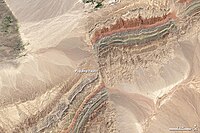
Photo from wikipedia
We investigated whether the joint inversion of geodetic and stress direction data can constrain long-term fault slip rates in the central Apennines, and ultimately how extension is partitioned among fault… Click to show full abstract
We investigated whether the joint inversion of geodetic and stress direction data can constrain long-term fault slip rates in the central Apennines, and ultimately how extension is partitioned among fault slip and bulk lithosphere permanent strain Geodetic velocities are collected in the fault interseismic stage with steady secular deformation;thus, long-term estimates can be derived with a model of elastically unloading seismogenic faults within a viscously deforming lithosphere As the average spacing of permanent Global Navigation Satellite Systems (GNSS) stations is similar to the average length of seismogenic faults (25?35 km), if not larger, we decided to merge permanent and temporary GNSS measurements, resulting in a denser geodetic data set Given that most normal faults in the Apennines have slip rates around or below 1 mm/a, and most campaign GNSS velocities carry similar uncertainties, simple local back slip models cannot be applied More sophisticated modeling is required to extract reasonable bulk deformation rates and long-term fault slip rates at signal-to-noise ratio of order unity Given the spatial distribution of the GNSS network, we estimated the long-term slip rate of seven major fault systems that are in satisfactory agreement with available geological slip rates The resulting spatial distribution of bulk deformation rates locally fits short-term transients;in other cases, they represent the currently unclear signature of tectonic processes like upper-crustal viscoplastic deformation and aseismic slip, or indicate missing faults in the adopted database We conclude that the time is ripe for determining fault slip rates using geodetic and stress direction data, particularly where fault activity rates are hard to determine geologically
Journal Title: Journal of Geophysical Research
Year Published: 2020
Link to full text (if available)
Share on Social Media: Sign Up to like & get
recommendations!